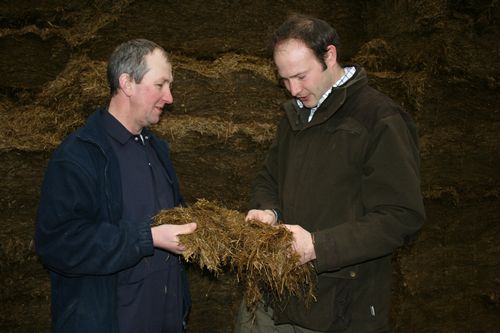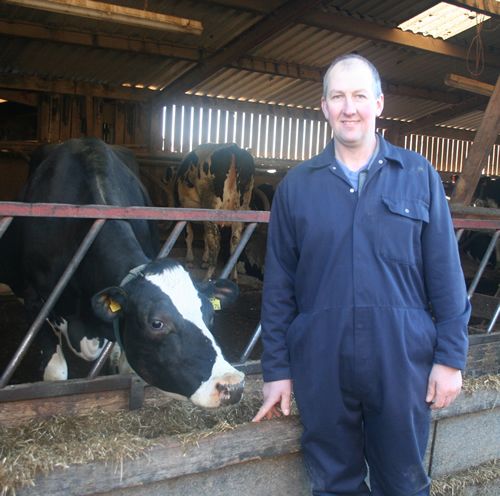
A big increase in silage dry matter intakes on a Lancashire dairy farm has lifted milk production by 900 litres a cow and enabled feed costs to be cut by £30 a head over the first 200-days of lactation.
"The milk went up and the costs went down," says Anthony Bretherton who runs the 135-cow Beaconside herd of pedigree Holsteins at Fellside Farm, Bleasdale, near Garstang.
"The analysis of our first cut silage showed a 72.9% D-value and 29.3% dry matter. With its high energy value we decided last August to reduce the bought-in energy ingredients of the cows’ ration. We cut the caustic wheat inclusion by 1kg a head per day and reduced the molasses by 0.5kg a day but the silage was good enough to cope and even to increase the yield."
The herd’s current average is 10,300kg at 4% fat and 3.2% protein but this winter yields have maintained an increase of three litres a day while continuing with the basic winter TMR diet of grass silage, caustic wheat, rapeseed, Amino-Max, molasses, soya hulls and Megalac.

"This time last year the herd average was 9,400 litres. In mid-January this year the milk records show our cows were averaging 37litres a day," says Anthony.
Silage ground at Fellside Farm is closed-up in mid-April after having received around 2000 gallons of slurry in January/February followed by a further 2000 gallons in early April after which fertiliser is applied. Last year the silage ground received 40 units of straight N per acre.
"We aim to take our first cut at the end of May but last year it was about a week later. The grass just wasn’t ready so we waited. It was cut by a contractor using a spreader mower and then tedded out within a few hours of being cut.
"The grass was going into the clamp in less than 12 hours and yielded about 900 tonnes from the 115 acres," said Anthony who used the silage additive Optimize Plus developed by Lancashire-based EnviroSystems.
"We felt confident about reducing the bought-in energy to reduce feed costs but we maintained the protein level of the diet. Dry matter intakes increased to around 32kg per head a day – that’s up by about six kilos compared with the previous year. Cow health has been good and we’ve been seeing heats more readily. By January we only had one cow that was un-served at over 60 days."
EnviroSystems consultant, Paul Rogerson explained: "The enzymes in the additive continue working for a long time. They help to open up the fibre structure (NDF), improving the fermentability and making more nutrients and energy available to the cow.
"By making the silage more fermentable we’ve reduced the lag time (speed of silage throughput in the rumen) which leads to increased dry matter intakes and makes more nutrients available to the cow."
Liz Russell of EnviroSystems says that if grass for silage is cut at two to three inches cutting height and as early as possible in May, there is more rapid re-growth to provide second cut that’s the same high quality as the first.
"Silage treated with Optimize Plus retains more plant juices which increases intake levels. Clamps should remain unopened for up to two months or longer if possible to maximise the stability and nutrient availability of the silage. This reduces waste and leads to more milk being produced from forage.
"Optimize Plus is one of the exceptions among silage additives in that it doesn’t contain lactobacillus. Silage can actually be made without any additive because lactobacillus is already present on the grass - so there’s no need to add more which only creates too much grass sugar that turns into lactic acid"
Liz Russell says the additive captures volatile "N" fractions which are often lost during silage fermentation.
"This ensures the true protein content remains very similar to fresh grass. NDF only has around three to four hours in the rumen so we want to make the nutrients easily available to the cow prior to her eating the silage.
"The enzyme needs time to work in the silage pit and this is where farmers can really influence and manage the nutrient availability of their silage. Treated silage left in the pit for three months or more will have an increased fermentable NDF compared with fresh silage which can be potentially worth up to two litres more milk per cow per day," says Liz Russell.
Summer grazing at Fellside Farm is based on a system of nine paddocks. Although no re-seeding has been undertaken for many years, last year’s grazing regime was modified.
"We used to turn out all the cows during the daytime in summer but housed the herd at night. Last year we decided to keep inside all the cows that calved from Christmas to May - day and night - and turn the rest of the herd out day and night.
"Most of the herd calves between June and the end of the year so we decided that as cows and heifers calved we’d keep them inside instead of turning them out to grass. The newly calved heifers really showed a big improvement with the best giving 700 litres more than we’d normally expect.
"We had 32 heifers inside at one stage and not one was giving less than 30 litres a day – and they were calving at two-years-old," says Anthony.
"The silage was clearly able to provide the cows with the energy they needed and that meant we could start saving on feed costs. In total we saved £30 a cow over 200 days."
For more information on Optimize Plus visit www.optimizeplus.co.uk or telephone EnviroSystems on 01772 860085
